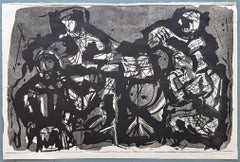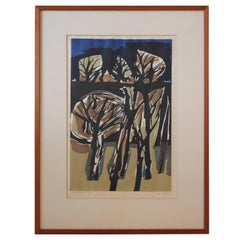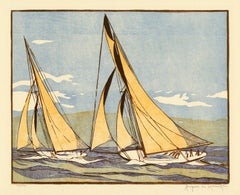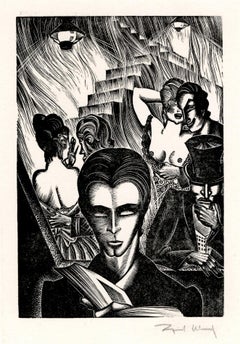Eugene Larkin Art
to
1
2
1
1
2
Overall Height
to
Overall Width
to
1
1
1
1
1
1
1
1
2
6,898
3,229
2,514
1,217
2
Artist: Eugene Larkin
Quartet No. 1
By Eugene Larkin
Located in Kansas City, MO
Eugene Larkin
Quartet No. 1
Woodcut in two colors
Signed and titled by hand
Size: 20 x 29.5 inches
COA provided
Eugene Larkin (1921-2010)
The late Eugene Larkin was an artist who worked in the Twin Cities area for many years and needs little introduction. His works have been shown, collected and appreciated by numerous galleries, museums and collectors throughout the United States.
Larkin was influential both as an artist and as a teacher. He taught at the Minneapolis College of Art and Design between 1954 and 1969, where he was head of printmaking and Chairman of the Division of Fine Arts. From 1969-1991 he was a professor in the Design Department at the University of Minnesota.
Eugene Larkin, a lithographer, teacher and artist who left behind scores of works, some of them in the permanent collections of the Library of Congress and the Museum of Modern Art. He was considered an early promoter of lithography education, Larkin introduced it into arts programs while teaching at the Minneapolis College of Art and Design and the University of Minnesota. He held a prominent place in the art world through decades of working and teaching in Minneapolis. His work depicted a wide range of subjects, from musicians to nature, including a series of woodcuts based on William Blake's ""Songs of Innocence and Experience."
Larkin also wrote a textbook, ""Design: The Search for Unity."" It was his work with lithography, an 18th-century printmaking process, for which he was best known.
His last local exhibit was a retrospective at The University of Minnesota Weisman Museum in 2005. ""Sometimes I start the artistic process from a literary source - Adam and Eve, the Egyptian nature gods, or classical Greek themes but sometimes I start from nature. Trees have always been a favorite subject. I see trees as people, as vertical objects...
Category
15th Century and Earlier Modern Eugene Larkin Art
Materials
Woodcut
"Autumn" Cubist Style Woodblock Print Edition 10/100
By Eugene Larkin
Located in Houston, TX
Woodcut print of fall trees done in heavy blacks with a deep blue background titled "Autumn" edition 10/100. Signed and titled by artist.
Artist Biography:
Eugene Larkin was born into a farming family of seven children in rural Minnesota in 1921. The landscape and rhythms of agricultural life were a strong early influence, as was the artistic example of his painter mother, Martha.
Larkin attended the University of Minnesota, graduating with an M.A. in 1947. As a student of the art historian Lawrence Schmeckebier, an authority on the art of the Mexican muralists, he was soon introduced to the expressionism and political engagement of German and Mexican artists of the 1920s and 30s. An early cycle of prints and drawings on the life of labor activist Joe Hill...
Category
1960s Abstract Eugene Larkin Art
Materials
Woodcut
Related Items
'The Start of the Race' — America's Cup, 1899
By Jacques La Grange
Located in Myrtle Beach, SC
Jacques La Grange, 'The Start of the Race, 1899', color woodcut, edition 500, 1934. Signed and numbered '21/500' in pencil. A fine impression, with fresh colors, on cream wove paper,...
Category
1930s American Modern Eugene Larkin Art
Materials
Woodcut
'Madman's Drum (Plate 41)' — 1930s Graphic Modernism
By Lynd Ward
Located in Myrtle Beach, SC
Lynd Ward, 'Madman's Drum, Plate 41', wood engraving, 1930, edition small. Signed in pencil. A fine, black impression, on off-white tissue-thin Japan paper; the full sheet with margins (1 5/8 to 2 1/2 inches); a small paper blemish in the upper right margin, away from the image, otherwise in excellent condition. Scarce. Matted to museum standards, unframed.
Image size 5 1/2 x 3 3/4 inches (140 x 95 mm); sheet size 9 5/8 x 7 1/8 inches (244 x 181 mm).
From Lynd Ward’s book of illustrations without words, 'Madman’s Drum', Jonathan Cape and Harrison Smith, New York, 1930. Illustrated in 'Storyteller Without Words: The Wood Engravings of Lynd Ward', Harry Abrams, New York, 1974.
Reproduced in 'Storyteller Without Words, the Wood Engravings of Lynd Ward', Harry N. Abrams, New York, 1974.
ABOUT THE ARTIST
Lynd Ward is acknowledged as one of America’s foremost wood engravers and book illustrators of the first half of the twentieth century. His innovative use of narrative printmaking as a stand-alone storytelling vehicle was uniquely successful in reaching a broad audience. The powerful psychological intensity of his work, celebrated for its dynamic design, technical precision, and compelling dramatic content, finds resonance in the literature of Poe, Melville, and Hawthorne. Like these classic American writers, Ward was concerned with the themes of man’s inner struggles and the role of the subconscious in determining his destiny. An artist of social conscience during the Great Depression and World War II, he infused his graphic images with his unique brand of social realism, deftly portraying the problems that challenged the ideals of American society.
The son of a Methodist preacher, Lynd Ward, moved from Chicago to Massachusetts at an early age. He graduated from the Teachers College of Columbia University, New York, in 1926, where he studied illustration and graphic arts. He married May Yonge McNeer in 1936 and left for Europe for their honeymoon in Eastern Europe. After four months, they settled in Leipzig, where Ward studied at the National Academy of Graphic Arts and Bookmaking. Inspired by Belgian expressionist artist Frans Masereel's graphic novel ‘The Sun,’ and another graphic novel by the German artist Otto Nückel, ‘Destiny,’ he determined to create his own "wordless" novel. Upon his return to America, Ward completed his first book, ‘God's Man: A Novel in Woodcuts,’ published in 1929. ‘Gods’ Man’ was a great success for its author and publisher and was reprinted four times in 1930, including a British edition. This book and several which followed it, ‘Madman’s Drum,’ 1930, ‘Wild Pilgrimage...
Category
1930s American Modern Eugene Larkin Art
Materials
Woodcut
Fat Stock Market
By Clare Leighton
Located in Myrtle Beach, SC
Clare Leighton, 'Fat Stock Market', 1933, wood engraving, edition 100, Boston Public Library 217. Signed, titled, and numbered '11/100' in pencil. A super...
Category
1930s Modern Eugene Larkin Art
Materials
Woodcut
'The Aquarium' — WPA Era 1930s Graphic Modernism
By Fritz Eichenberg
Located in Myrtle Beach, SC
Fritz Eichenberg, 'The Aquarium', wood engraving, 1933, edition 200. Signed and titled in pencil. Initialed in the block, lower right. A superb, richly-inked impression, on pale yel...
Category
1930s American Modern Eugene Larkin Art
Materials
Woodcut
Wild Pilgrimage, No. 26
By Lynd Ward
Located in Myrtle Beach, SC
Lynd Ward, 'Wild Pilgrimage', No. 26, wood engraving, 1932, edition not stated but very small. Signed in pencil. A fine, black impression, with full margins (1 1/16 to 3 3/16 inches), on tissue-thin cream Japan paper, in very good condition. Matted to museum standards, unframed. Scarce.
Created by Lynd Ward for his narrative book of illustrations without words, 'Wild Pilgrimage', published by Harrison Smith...
Category
1930s American Modern Eugene Larkin Art
Materials
Woodcut
'Simplicius' Farewell to the World' — Graphic Modernism
By Fritz Eichenberg
Located in Myrtle Beach, SC
Fritz Eichenberg, 'Simplicius’ Farewell To The World' from the suite 'The Adventurous Simplicissimus', wood engraving, 1977, artist's proof apart from the edition of 50. Signed in pencil. Signed in the block, lower right. A fine, richly-inked impression, on cream wove paper, with full margins (1 1/2 to 2 inches), in excellent condition. Image size 14 x 12 inches (356 x 305 mm); sheet size 17 1/2 x 15 inches (445 x 381 mm). Archivally sleeved, unmatted.
ABOUT THIS WORK
'Simplicius Simplicissimus' (German: Der abenteuerliche Simplicissimus Teutsch) is a picaresque novel of the lower Baroque style, written in five books by Hans Jakob Christoffel von Grimmelshausen published in 1668, with the sequel Continuatio appearing in 1669.
The novel is told from the perspective of its protagonist Simplicius, a rogue or picaro typical of the picaresque novel, as he traverses the tumultuous world of the Holy Roman Empire during the Thirty Years' War. Raised by a peasant family, he is separated from his home by foraging dragoons. He is adopted by a hermit living in the forest, who teaches him to read and introduces him to religion. The hermit also gives Simplicius his name because he is so simple that he does not know his own name. After the death of the hermit, Simplicius must fend for himself. He is conscripted at a young age into service and, from there, embarks on years of foraging, military triumph, wealth, prostitution, disease, bourgeois domestic life, and travels to Russia, France, and an alternate world inhabited by mermen. The novel ends with Simplicius turning to a life of hermitage, denouncing the world as corrupt.
ABOUT THE ARTIST
Fritz Eichenberg (1901–1990) was a German-American illustrator and arts educator who worked primarily in wood engraving. His best-known works were concerned with religion, social justice, and nonviolence.
Eichenberg was born to a Jewish family in Cologne, Germany, where the destruction of World War I helped to shape his anti-war sentiments. He worked as a printer's apprentice and studied at the Municipal School of Applied Arts in Cologne and the Academy of Graphic Arts in Leipzig, where he studied under Hugo Steiner-Prag. In 1923 he moved to Berlin to begin his career as an artist, producing illustrations for books and newspapers. In his newspaper and magazine work, Eichenberg was politically outspoken and sometimes wrote and illustrated his reporting.
In 1933, the rise of Adolf Hitler drove Eichenberg, who was a public critic of the Nazis, to emigrate with his wife and children to the United States. He settled in New York City, where he lived most of his life. He worked in the WPA Federal Arts Project and was a member of the Society of American Graphic Artists.
In his prolific career as a book illustrator, Eichenberg portrayed many forms of literature but specialized in works with elements of extreme spiritual and emotional conflict, fantasy, or social satire. Over his long career, Eichenberg was commissioned to illustrate more than 100 classics by publishers in the United States and abroad, including works by renowned authors Dostoyevsky, Tolstoy, Charlotte and Emily Brontë, Poe, Swift, and Grimmelshausen. He also wrote and illustrated books of folklore and children's stories.
Eichenberg was a long-time contributor to the progressive magazine The Nation, his illustrations appearing between 1930 and 1980. Eichenberg’s work has been featured by such esteemed publishers as The Heritage Club, Random House, Book of the Month Club, The Limited Editions Club, Kingsport Press, Aquarius Press, and Doubleday.
Raised in a non-religious family, Eichenberg had been attracted to Taoism as a child. Following his wife's unexpected death in 1937, he turned briefly to Zen Buddhist meditation, then joined the Religious Society of Friends in 1940. Though he remained a Quaker until his death, Eichenberg was also associated with Catholic charity work through his friendship with Dorothy Day...
Category
1970s American Modern Eugene Larkin Art
Materials
Woodcut
Autumn — American Modern
By Charles Turzak
Located in Myrtle Beach, SC
Charles Turzak, 'Autumn', color woodcut, edition 50, c. 1925. Signed, titled and numbered '17/50' in pencil. Signed in the block, lower left. A fine impression, with fresh colors, on...
Category
1920s American Modern Eugene Larkin Art
Materials
Woodcut
'City Lights' — Vintage Wood Engraving, New York City, 1934
By Fritz Eichenberg
Located in Myrtle Beach, SC
Fritz Eichenberg, 'City LIghts', wood engraving, 1934, edition 200. Signed, titled 'Lights', and annotated 'No 2/200 for Howard M. Chapin' in pencil. Initialed in the block, lower right. A fine, richly-inked black impression, on cream wove paper, with full margins (1 1/4 to 1 7/8 inches); a small loss (5/8 inch) in the top right sheet corner, well away from the image, otherwise in excellent condition. Printed by master printer Ernest Roth...
Category
1930s American Modern Eugene Larkin Art
Materials
Woodcut
Allen Street El —mid-century modern
By Bernard Brussel-Smith
Located in Myrtle Beach, SC
Bernard Brussel-Smith, 'Allen Street El', chiaroscuro wood engraving, 1941, edition 140. Signed, titled, and numbered '84/140' in pencil. Signed and dated in the block, upper right. ...
Category
1940s American Modern Eugene Larkin Art
Materials
Woodcut
'The Magic Is Ahead' — America's Cup, 1870
By Jacques La Grange
Located in Myrtle Beach, SC
Jacques La Grange, 'The Magic Is Ahead, 1870', color woodcut, edition 500, 1934. Signed and numbered '21/500' in pencil. A fine impression, with fresh colors, on cream wove paper, wi...
Category
1930s American Modern Eugene Larkin Art
Materials
Woodcut
'Racing in a Storm' — America's Cup, 1885
By Jacques La Grange
Located in Myrtle Beach, SC
Jacques La Grange, 'Racing in a Storm, 1885', color woodcut, edition 500, 1934. Signed and numbered '21/500' in pencil. A fine impression, with fresh colors, on cream wove paper, wit...
Category
1930s American Modern Eugene Larkin Art
Materials
Woodcut
'The Steps' — WPA Era 1930s Graphic Modernism
By Fritz Eichenberg
Located in Myrtle Beach, SC
Fritz Eichenberg, 'The Steps', wood engraving, 1933, edition 200. Signed, titled, and annotated 'Ed. 200' in pencil. Initialed in the block, lower right. A superb, richly-inked impr...
Category
1930s American Modern Eugene Larkin Art
Materials
Woodcut
Eugene Larkin art for sale on 1stDibs.
Find a wide variety of authentic Eugene Larkin art available for sale on 1stDibs. You can also browse by medium to find art by Eugene Larkin in woodcut print and more. Much of the original work by this artist or collective was created during the 20th century and is mostly associated with the modern style. Not every interior allows for large Eugene Larkin art, so small editions measuring 20 inches across are available. Customers who are interested in this artist might also find the work of Will Petersen, August Mosca, and Alexander Archipenko. Eugene Larkin art prices can differ depending upon medium, time period and other attributes. On 1stDibs, the price for these items starts at $290 and tops out at $575, while the average work can sell for $500.



